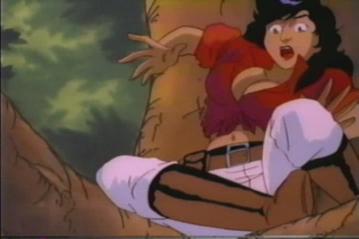Introduction
Welcome to a world gone mad.
In the Xenozoic, dinosaurs roam with humans and old cars race brand new
woolly mammoths. In this future time, all of Earth’s ages have blended.
Two people want to find out why. They are Jack Tenrec, part mechanic, part
nature shaman, full time hothead; and Hannah Dundee, scientist, diplomat,
rational thinker...and maybe something more.
Together, they seek the answers to the riddles of the Xenozoic.
Come with them.
What they find is inside... |
| excerpt from Xenozoic
Tales #11 |
In 1987 a new magazine called XENOZOIC
TALES wandered into comics shops, sat down, and refused to be categorized.
Created, written, and mostly drawn by a newcomer named Mark Schultz, its
publisher was Denis Kitchen’s small but quality-minded Kitchen Sink Press.
It quickly became clear that XT was more than the sum of its influences --
writers such as Edgar Rice Burroughs, and the E.C. WEIRD SCIENCE comics of
the 1950s, especially tales drawn by Wally Wood, Al Williamson, and Frank
Frazetta. Over the years, Mark has won various awards for his creation,
his stories, his artwork, and deservedly so. |
| excerpt from "A FEW WORDS OF
INTRODUCTION TO TOPPS COMICS' CADILLACS AND DINOSAURS" (Topps Comics #1) |


Xenozoic Tales. "Refused to be categorized" is apt. Featuring wild tales
of a strange, regressive future where man lives among the dinosaurs, its
lavishly detailed panels contained everything from intense combat with poachers,
scuffling with political leaders, mystical prophecies, and even a dose of simple
slice of life. Its storyline wasn't quite flowing, but it wasn't exactly
episodic either - like a lot of elements of the comic, it can't be easily
described in brief sentences, but the fact remains that it was most certainly
intriguing and high-quality stuff.
And then somebody thought, hey, this would make a perfect cartoon! It's got
dinosaurs, it's got cool cars, and come on, the name of the trade paperback is
friggin' awesome.
In the early 90s Marvel Comics' Epic
line published a color version of XT #1-6, under the C&D name, with new
covers.
And in 1993, that hydra-headed beast we lump under the umbrella name
"Hollywood" finally sat up and took notice. Dinosaurs were suddenly in --
and CADILLACS AND DINOSAURS became a cartoon series from CBS-TV.
Though the young TV audience necessitated certain adjustments, more of
Mark’s vision made it to the small screen than one might have expected.
When was the last time you heard Scooby-Doo using a Latin phrase like "Machinatio
Vitae"? |
| excerpt from "A FEW WORDS OF
INTRODUCTION TO TOPPS COMICS' CADILLACS AND DINOSAURS" (Topps Comics #1) |


Like a lot of shows I've covered, I'm
unsure how or why this show came to be, whether it was Mark Schultz actively
seeking to extend his franchise or if it was Nelvana's decision, doing what they
usually do by making shows from oddball source material. Given the success of
the slightly-more-mature-than-the-norm X-Men cartoon from the previous
year, I wouldn't be surprised if Cadillacs was spawned as an attempt to
ride that wave. And despite how gritty the original comic can be, I'd say it
didn't convert over too badly.
Sure, the frequent deaths were
dropped like a flea-ridden dog, and status quo is firmly set in stone in
contrast to the series' constantly evolving dynamic, but the vibe of whimsy,
danger and excitement are maintained pretty well. Although a lot more
light-hearted, Jack still gets into trouble with the city council, has run-ins
with poachers, is still frequently chased by rabid slithers, and exchanges
snarky comments with Hannah Dundee. You could argue that the stories aren't as
enjoyable without the gritty realistic danger present in the comics, and that
the often outrageous elements such as killer mining robots and freakin' lava
cannons make the setting less like post-apocalyptic Earth and more like a
supervillains convention, but it's freakin' Cadillacs and dinosaurs! When you
accept that much you can't just go setting limits to how much you'll tolerate,
man.
The cartoon, while not perfect, is a
fun little romp, and the fact it even got a chance to exist at all is worth
commending. I do feel if the cartoon had emulated the constantly ongoing
storyline like the comics (and the X-Men cartoon, for that matter) it could have
spring boarded some great plots (an adaptation of the Fessenden saga would've
been pretty rad!), but as it is, it remains a reasonably enjoyable little show.